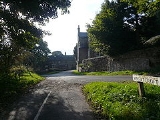
Wheatcroft, Derbyshire
Encyclopedia
Wheatcroft is a small hamlet in the hills of Amber Valley
, near Crich
, Derbyshire
, England
. Wheatcroft has no shop or church and while it once had a chapel it has been renovated into a small second home.
Wheatcroft is split into two areas; Wheatcroft Mount and Lower Wheatcoft. Over twenty people live in permanent residence.
Wheatcroft has been in continued existence since 1066 as it is mentioned in the Domesday Book
as having "4 houses" 1210 as it was recorded in a same of land under the name of "watedroft" Further evidence to support the antiquity of Wheatcroft comes from the early 15th century as one of the larger houses is said to have dated from the this period. Until the mid 20th century a fayre came to Wheatcroft but that has since stopped. One of the houses was used in the ITV drama Peak Practice.
Of the houses three were built on land granted by the Lord of Wingfield Manor in the 17th Century and were built from stone quarried from the village quarry, as most likely were most of the others. In addition to the chapel, as above now renovated into a second home, the village used to possess a Village Institute in which weekly social gatherings were held until the 1950s and over the years various shops including a general store and until the 1960s a lubricant and engineering shop. Two of the houses have medieval cruck barns as part of their outhouses and one of the houses used to be owned by the Hopkinson Nightingale family, a branch of the Nightingale family from Lea Hurst, the childhood home of Florence Nightingale.
Amber Valley
Amber Valley is a local government district and borough in Derbyshire, England. It takes its name from the River Amber and covers a semi-rural area with a number of small towns formerly based around coal mining and engineering...
, near Crich
Crich
Crich is a village in Derbyshire in England. It has the National Tramway Museum inside the Crich Tramway Village, and at the summit of Crich Hill above, a Memorial Tower for those of the Sherwood Foresters regiment who died in battle, particularly in World War I.Built in 1923 on the site of an...
, Derbyshire
Derbyshire
Derbyshire is a county in the East Midlands of England. A substantial portion of the Peak District National Park lies within Derbyshire. The northern part of Derbyshire overlaps with the Pennines, a famous chain of hills and mountains. The county contains within its boundary of approx...
, England
England
England is a country that is part of the United Kingdom. It shares land borders with Scotland to the north and Wales to the west; the Irish Sea is to the north west, the Celtic Sea to the south west, with the North Sea to the east and the English Channel to the south separating it from continental...
. Wheatcroft has no shop or church and while it once had a chapel it has been renovated into a small second home.
Wheatcroft is split into two areas; Wheatcroft Mount and Lower Wheatcoft. Over twenty people live in permanent residence.
Wheatcroft has been in continued existence since 1066 as it is mentioned in the Domesday Book
Domesday Book
Domesday Book , now held at The National Archives, Kew, Richmond upon Thames in South West London, is the record of the great survey of much of England and parts of Wales completed in 1086...
as having "4 houses" 1210 as it was recorded in a same of land under the name of "watedroft" Further evidence to support the antiquity of Wheatcroft comes from the early 15th century as one of the larger houses is said to have dated from the this period. Until the mid 20th century a fayre came to Wheatcroft but that has since stopped. One of the houses was used in the ITV drama Peak Practice.
Of the houses three were built on land granted by the Lord of Wingfield Manor in the 17th Century and were built from stone quarried from the village quarry, as most likely were most of the others. In addition to the chapel, as above now renovated into a second home, the village used to possess a Village Institute in which weekly social gatherings were held until the 1950s and over the years various shops including a general store and until the 1960s a lubricant and engineering shop. Two of the houses have medieval cruck barns as part of their outhouses and one of the houses used to be owned by the Hopkinson Nightingale family, a branch of the Nightingale family from Lea Hurst, the childhood home of Florence Nightingale.

